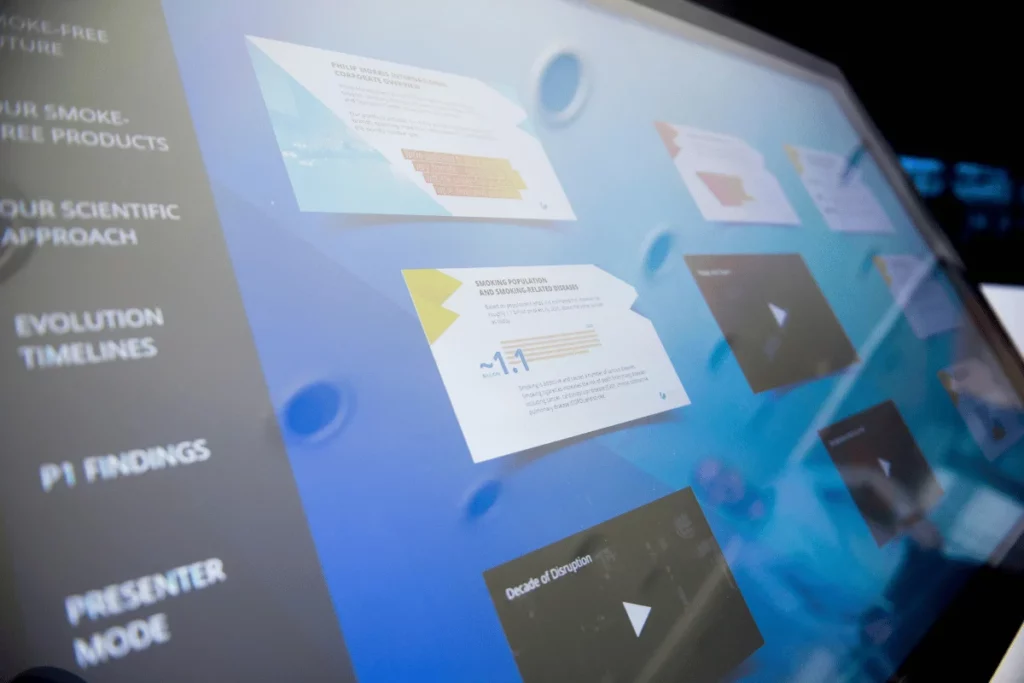Design always builds on UX research. And the best designed products come to life because of a sound user research strategy.
Take one of the best-known examples — Apple products are sleek and stunning. The act of merely unboxing a new Apple device is a thrill. The compelling design made competitors stand up, take notice and try to emulate them.
Apple raised the bar for tech companies by deeply understanding that users want more than just a product. They want an experience.
The ultimate goal of user research is to understand more about users, particularly their needs and pain points. How does your product or service address those needs and eliminate those grievances? It can be daunting to kickstart your research journey.
But don’t worry. We have some great tips on how to create a user research strategy.

Why Do I Need a User Research Strategy?
Eva is the first researcher at a golf coaching company, Golf-in-class (GIC). Her task is to assist the organization with research for their new application, which (hopefully) will enable golfers to book lessons via their smartphone, watch instructional videos and purchase items from an online merchandise store.
Where does Eva begin?
She creates a user research strategy. A user research strategy provides a framework, pipeline and understanding of research projects at a company. Projects are tied to strategic questions, along with tactical initiatives or studies that will help answer them.

Key Elements of an Effective UX Research Plan
Here’s a list of essential ingredients that go into baking the perfect UX research pie plan:
Vision
A company’s vision is a statement that clearly defines the desired future state of a product. An aspirational and ideal state that companies wish to achieve. It describes the value delivered to end users and the impact it’ll have on their behavior.
Developed over time, a company’s vision establishes the north star for its UX strategy. Vision statements align key stakeholders around the end user. They guide decisions throughout the product life cycle.
Goals
A vision statement talks about a product’s final destination, not how to get there. Goals include detailed and specific objectives that a product aims to achieve. Metrics and KPIs describe what products must achieve in concrete, measurable terms.
Goals act as a guideline for the entire process. They help you evaluate the success of your UX research plan. Follow the SMART framework to define product goals. That is, they must be specific, measurable, achievable, relevant, and time-bound.
Plan
A plan is a detailed document listing the steps needed to achieve a specific goal. As product teams follow a roadmap, it’s beneficial for research teams to create their own. Intertwined with product development, research roadmaps detail user needs and problems.
Roadmaps provide information about UX research initiatives. Each initiative links to an overarching product goal. Plans document details of each initiative – a mix of activities, resources, timelines, and deliverables.
Remember, plans change as new information or insights emerge. The key to a good research plan is the flexibility to pivot.
People
It’s easy for researchers not to look past the customer. Every project gears itself towards improving the end-user experience. However, drafting a robust research plan requires cross-functional collaboration.
How will you get stakeholder buy-in? How do they benefit from research initiatives? Gather their requirements with a brainstorming session. This ensures diverse perspectives in the planning process and aligns everyone toward your UX goals.
Processes
What processes must be in place to guarantee an effective implementation of the plan?
Document the research methods that you’ll use. Outline the techniques and frequency of these processes. Include what kind of analysis you’ll conduct on collected data. What software or tools will you need?
A plan also establishes core UX design and research principles. This maintains consistency across all UX initiatives. Includes criteria for adding features and testing methods and protocols.

UX Strategy Framework Explained
Eva uses the following UX strategy framework to ensure projects stay on course. Including each one of these critical components makes her UX research and strategy iron-clad:
| Component | Description | GIC Research Plan |
| Problem Statement | Describes what fundamental user problem the research aims to solve. | Golfers have no organized marketplace to book and manage lessons. Existing processes are analog, tedious & manual. |
| Research Question | What questions will research help answer? How will it help achieve business goals? | What problems do users currently face while booking lessons? How does the app address them? How will we attract new users and expand the user base (and therefore sales)? What features do users desire in said app? |
| Objectives | Establish clear objectives that address the end goal of your research. | Interview golfers to understand their lesson booking process and any red tape or issues they face. Incorporate user feedback into an app prototype. One that facilitates lesson booking, a merchandise store, and educational content. Identify user navigation through the app and evaluate ease of use with usability testing. |
| Target Audience | Identify target users. Define user personas with demographic, psychographic & behavioral patterns. | Golfers at beginner and intermediate levels. Of various age groups. Further research helps develop personas. |
| Research Method | Establish the type of user research method you will use. The right one helps uncover critical data about the user experience. | Interviews, focus groups, field studies, and contextual inquiry. |
| Stakeholders | Who is your research for? Who benefits from insights? | GIC’s product, design, development & marketing teams. End users. |
| Resources | How much time, finances, and manpower will the company allocate to research project(s)? | 16 weeks ~ 4 months $20,000 Eva + junior researcher (contract) |
| Timelines | What’s the project’s timeframe? Establish milestones and deadlines to keep research on track. | Preliminary research = 3 weeks App development = 8 weeks Prototyping + feedback = 2 weeks Update & soft launch = 2 weeks |
| Analysis | Describe the analysis methods used. The right one helps convert raw data into meaningful insights. | Thematic analysis Usability testing |
| Metrics | Define KPIs and metrics that determine success. | App signups # of daily users # of bookings $ sales from the merchandise store |
UX Strategy Fundamentals for Product Teams
Embrace these fundamentals to create products that resonate deeply with your users:
- Foster a user-centric culture: Put user needs at the heart of every decision. This creates alignment across the organization. Teams will consider how decision-making impacts the end user. As a result, product teams become more outcome-focused rather than feature-focused.
- Promote Collaboration: Engage with cross-functional teams throughout the product lifecycle. Including designers, developers and marketers early on ensures alignment towards the same objectives. This fosters a holistic and cohesive approach toward product development.
- Be Flexible: When new insights come to light, product teams must shift their focus (and resources). Ensure your UX strategy is adaptable – so you can react to evolving market trends and user preferences. Being more flexible reduces the need for costly changes in the future.
- Continuously Improve: Creating a UX strategy isn’t a “set-it-then-forget-it” gig. Ensure that research is an iterative process. Conduct user testing periodically. Close the customer feedback loop throughout the lifecycle. This ensures a product always stays relevant and user-focused.

A Good User Research Strategy
- Develops a customer-centric culture: People across the organization develop user empathy by listening to frustrations, motivations and goals. A user research strategy aligns everyone around one goal – to help their users.
- Effectively allocates resources. Based on the importance and time sensitivity of research projects, a strategy helps prioritize studies in line with the product, design and engineering teams’ more urgent needs.
- Provides concrete success metrics. Define what success is and how it’s measured at the outset. This aids in quantifying product decisions and keeps everyone on track.
- Communicates the value of research across the organization. Research is a continuous process and provides ongoing learnings about users. Employees from various teams can access, benefit and act on research insights. Over time, reliance on research grows stronger.
A helpful tool to help chart the user research journey is a research roadmap. Closely tied to a product roadmap, a research roadmap lays out the path ahead, where one can oversee and guide individual research projects. Each project is linked to an overarching business goal. Project details such as scope, methodology and checkpoints are all easily accessible and retrievable from the roadmap. A research roadmap can also include documentation with principles and best practices to guide new researchers or non-researchers through the process.

User Research Starts With Discovery
Before diving headfirst into conducting research, take a step back and consider the overall objectives.
First, Eva must identify potential beneficiaries of her research. Who are the relevant stakeholders and what insights are they looking for? Product and design teams at GIC will likely benefit from user research while developing the app, but what about sales, marketing and upper management? They too can use insights to understand their demographic – learn more about their buying patterns and preferred channels of communication.
By involving them from the beginning, Eva can understand exactly what questions each team needs answers to. After collating questions and interest areas from each team, she must now decide what research methodology to use and when.
In the product development life cycle, research occurs in three phases:
| Phase | Method | Description |
| Discovery | Diary Studies | Gather qualitative data about user activities and experiences over time. Insights help you understand behavior of the target audience. |
| Focus Groups | Getting a broad view of the audience & insight into a group of people with a quick turnaround | |
| Ethnography | Observe people in the context of their daily lives | |
| Field Studies | Observe people in their natural environment | |
| Generative interviews | Interviews to discover more about user goals, motivations, pain points and attitudes | |
| Validation & testing (Prototypes) | Qualitative usability testing | How ‘usable’ is your product? Conducted in small groups |
| Tree testing | Testing the architecture of your website / app – examines how users navigate the interface | |
| First-click testing | Measures where users first click on your website / app | |
| Task analysis | Analyze how users perform tasks. Helpful when testing product features. | |
| A/B testing | Testing one option against another | |
| Accessibility testing | Is the website / app accessible to differently-abled individuals? A step towards more conscious, inclusive design | |
| Ongoing (post product launch) | Analytics | Quantitative & qualitative analytics |
| Surveys | Measure user attitudes towards a product, and their preferences & feelings about particular features |
Qualitative research plays a crucial role in the discovery phase as researchers seek to understand more about the user experience and generate hypotheses. During validation and testing, methods tend to be more quantitative and statistically-driven, as real-life testing is conducted on the product or app. Here, researchers vigorously test hypotheses quantitatively. Despite the quantitative rigor, qualitative user feedback at this stage is crucial to the success of the product. Once the product is launched, a researcher’s work doesn’t stop. To continually improve their product and the user experience, they must collect both qualitative and quantitative data about how users interact with the product.
Learn more about when to use quantitative vs. qualitative research.
Work on GIC’s app hasn’t even begun, and given the high time and money costs associated with ethnographic and diary studies, Eva decides to go with a combination of interviews, focus groups and field studies to gather more information about potential users. She decides to visit driving ranges at a host of local golf clubs to conduct her research.
Your User Research Strategy Needs Personas
Who are potential GIC app users? What do they think? What motivates them? Eva likely gained this deeper understanding of golfer’s needs and pain points from her interactions at driving ranges. How does she use this newly-acquired information to understand more about potential GIC app users?
Create user personas. User personas enable a deep understanding of the target audience for any product. A user persona is a typical user whose characteristics and attitudes are representative of a much larger group of users. It can include basic demographic data such as gender, income level, education, marital status and location. Personas also include traits such as goals or motivations, frustrations, preferences, biases and other social and cultural information. There’s a debate whether to include or omit basic demographic data while creating user personas, as it can create biases, unfair assumptions and generalizations about these users.
User personas help designers create better products, as they have specific, not generic users in mind. Traits of a generic or elastic user are loosely defined, and can vary in the minds of different stakeholders. Creating a user persona helps product and design teams identify users they are designing for — it personifies (for lack of a better word) the user and brings their voice into the conversation.
Golf is a game played by all age groups, Eva concluded from her research. She noticed a lot of young children accompanied by their parents at lessons. It occurred to her that the parents (aged 40+) would be the ones interacting with the app. While constructing a user persona of a typical parent, Eva noted, Parents may not be as tech savvy as millennials or younger age groups, therefore they would likely favor simplicity while navigating through the GIC app.
User personas build user empathy and put designers (and beyond) in the user’s shoes. How do we map user needs to their experiences while immersed in our product? Parents are looking for an easy way to book lessons for their kids, and wouldn’t be too enticed by the merchandise shop or videos. What about the user persona of golf coaches who will use the GIC app? Their interaction must be simple too – ideally they’d like to view their lessons in a calendar format, and be apprised of any schedule changes via notification.
Creating user personas also helps avoid self-referential design – where designers create products chiefly for themselves. Their audience may be vastly different from their own personality traits and preferences. Without understanding their users, designers may add features and functionality without questioning whether it’s really needed or not. Adding a mobile golf game within the app might confuse parents who are simply on the app to book a lesson. User personas help decide what’s necessary and what isn’t. The best user personas are based on real field research and user interviews, but creating temporary personas is a good starting point.

User Interviews Validate Your User Research
One research methodology was left off the list above. Typically conducted before the launch of a product, contextual inquiry is a valuable weapon in the researcher’s arsenal. So what is contextual inquiry?
As its name suggests, contextual inquiry involves researchers observing users in their natural environment and asking questions to fill in the gaps of their observations. Researchers observe the user as they perform tasks — there’s a constant dialogue between the two, with the researcher asking how and why the user is performing a certain act.
Eva decides to conduct some contextual inquiry research with a prototype app created by the product and design teams. These semi-structured interviews record users’ thoughts and gauge how quickly and easily they perform certain tasks within the app, such as booking a lesson or buying a golf cap.
Eva conducts her research one user at a time, and puts participants at ease by letting them know that it’s not them being tested, but the GIC prototype. She observes what they do when given a task, documents what they are doing, and also engages in constant dialogue to gauge user emotions and thoughts.
Researchers should be able to decode a user’s body language and grasp their emotions even while the user is not speaking. Eva notices some seniors (aged 60+) struggle and grimace while purchasing items from the merchandise store — these nonverbal cues are important. She notes that the navigation must be easier to understand for all users, and also calls attention to a glitch in the merchandise store’s checkout process.
Ordinary surveys and interviews rely on the user’s ability to recall a process — users don’t share their reasoning, motivation and mental state. As a result, these items aren’t captured and the researcher is left with a superficial understanding of the user’s approach. This isn’t the case with contextual inquiry — it provides richer and more relevant information because users talk about what they are doing while doing it. Observing them in their natural environment (the driving ranges) gives Eva access to more accurate, user-centered information.
Contextual inquiry is crucial in shaping design choices such as requirements, personas, features and product architecture. It can be used at any point during product development, from designing a user interface to testing a product and determining any flaws. Researchers also get insight into user behavior within their product and can anticipate use cases for their app.

How to Develop a UX Research Strategy
Follow these steps to create a clear, comprehensive, and actionable UX research strategy:
- Outline business strategy: Tie UX research to overarching business goals. Involve leadership and key stakeholders early on. Understand how research will support their departmental objectives.
- Conduct preliminary research: Market research helps you understand the competitive landscape. Where will your product lie within the marketplace? Map the user journey. How do users currently solve their problems? Understand user goals, needs, and pain points. What value will you offer to the end user?
- Set specific goals: Define the UX design strategy outcomes you want to achieve. Establish principles and criteria for assessing solutions. Create a roadmap detailing initiatives. Establish expectations of how you’ll achieve the goals.
- Choose methods and tools: Will studies be quantitative, qualitative, or both? In-person or online? What methodology fits with your research objectives and target audience? Consider budget, time, and manpower before making a choice. Set up a free demo with Marvin to see how it augments your research process.
- Analyze data: Once you’ve collected data, it’s time to extract meaningful and actionable insights. A combination of statistical and thematic analysis helps you develop detailed user personas. Understand what users do and why they do it.
- Establish success metrics: How will stakeholders measure product success? Metrics and KPIs help you measure progress towards UX objectives. Tie them to user behavior and business outcomes. Monitor metrics and set targets and benchmarks for improvement.
- Present findings: Use visual storytelling to communicate research findings to relevant stakeholders. Recommend an approach, direction, and solutions. Don’t overwhelm them with data. Make it short, relevant, and easily digestible.
- Iterate. Validate your approach with users through further UX research. Repeat the process and delve deeper into user behavior.

Steps to Integrate UX Research and Strategy in Product Development
Structuring your UX research and strategy helps drive every stage of product development. It informs decision-making, helping identify potential roadblocks early on. Furthermore, it ensures that everyone keeps users in mind throughout the development process.
Follow these steps to incorporate your user experience strategy into every stage:
1. Discovery
Incorporate research during the product ideation phase. Discovery is all about attaining foundational knowledge. Research methods such as field studies and user interviews help you understand the problem space. Gather user requirements and project constraints by conducting:
- Field studies: Observing users in their natural environment sheds light on their behavior and preferences.
- Interviews: Interview stakeholders to understand their business goals. Talk to users to decipher their needs, motivations, and frustrations.
2. Exploration
Once you’ve got a handle on user problems, it’s time to explore how to solve them. This stage involves assimilating information to inform design decisions. Use the following methods to drive your UX design strategy:
- Journey mapping: Visualize the user journey from beginning to end. Provides a holistic view of a user’s experience. Uncovers their impressions and perspectives after using a product.
- Persona creation: How will different user groups interact with your product? Create different personas to humanize users. This helps designers create products with end users in mind.
- Design review: Benchmark competitor designs to understand design best practices. Also, scan them for bugs, roadblocks, and other pitfalls to avoid. Card sorting exercises help you create a user-friendly information architecture.
3. Testing
Once you’ve created a design, it’s time to put it to the test. Recruit real-world users to evaluate design options. Employ several different research methods to ensure the effectiveness of your proposed design(s):
- Usability testing: Evaluate the quality of your prototype(s). Use heatmaps, screen recordings, and A/B testing to validate your assumptions. Identify roadblocks and bugs in the UI. Test designs in person or remotely.
- Customer feedback: Solicit qualitative feedback from customers. Marrying these insights helps in understanding the underlying motives of user behavior.
4. Listening
Companies must practice active listening once their products go to market. Keeping your finger on the pulse of the customer allows you to continuously improve your offerings. Use the following to garner insights:
- Surveys: Structured feedback allows teams to gather data from a large user base. It helps to quantify trends and identify areas of improvement.
- Customer reviews & stories: Use customer stories to understand the user journey. Decipher what customers like and, more importantly, what they don’t.
Without a plan, product teams are shooting in the dark. With no concrete data to back up decisions, they take on more risk. This results in poor user experiences. Research shouldn’t be an afterthought. It’s the foundation from which product development begins.

Frequently Asked Questions (FAQs)
Let’s address some frequently asked questions about UX research and strategy:
What is the Difference Between User Experience Strategy and UX Research?
User experience strategy is a high-level outline that encompasses all UX initiatives. It includes goals and a roadmap and guides a product’s development. A UX strategy aligns its goals with overarching business objectives.
UX research includes various methods for collecting and analyzing user data. This includes planning and conducting research via surveys, interviews, focus groups, or observational studies. The primary goal of user research is to collect and analyze user data, thus informing business decisions.
How Does a UX Strategy Blueprint Improve Product Development?
Implementing a UX strategy blueprint into product development has several benefits:
- Aligns stakeholders toward achieving business goals.
- Allows for flexibility of research efforts as new insights emerge. Teams scale efforts as the product grows.
- Identify and fix issues earlier in the development process before they snowball into bigger ones. Saving time, money, and man-hours in the long run.
- Promotes user-centricity, ensuring teams think about users at every stage. Everyone focuses wholly on creating a memorable user experience.
- Customized products improve user satisfaction. This increases user engagement and retention. Customers remain brand loyal, creating a competitive advantage.
What Are the Fundamentals of UX Research and Strategy?
The fundamentals of UX research and strategy include:
- Purpose: Communicate a vision of the customer problems you’re trying to solve. Includes specific research goals and aligns them with business goals.
- Plan: Outlines research initiatives to achieve goals. Identifies the relevant research methods for studies. Allocates resources to research projects. Documents processes and protocols to carry out research.
- People: Identifies end users and develops user personas to better understand their needs.
Why is User Experience Planning Crucial for a Successful Product?
What makes a successful product? A loyal user base and the ability to generate revenue.
User experience planning helps designers and researchers better understand user needs. They focus on designing intuitive solutions to customer problems. It increases a company’s adaptability to emerging market trends.
Building products with users in mind leads to higher user satisfaction and retention. Brand loyalty drives increased sales and better business performance.
Conclusion
There are a few reasons why UX design strategy is important.
A sound user research strategy sets the stage for intentional and purposeful inquiry.
Focusing on the user promotes customer-centricity across the organization. Unearth user needs and design solutions built for them. Validate your designs by planning user testing and feedback collection. Pivot your research efforts as new trends emerge.
UX research strategy provides direction. It aligns research initiatives with business goals.

Kickstart Your User Research Strategy
Eva’s research enabled GIC’s product and design teams to collect important demographic and behavioral insights about their users. They end up with a no-nonsense, easy-to-use application for golfers and coaches alike. Collating existing insights, and executing research as part of Eva’s strategy was crucial to the successful rollout of their app.
Whatever research strategy and methodology you decide to employ, it’s vitally important to document your work and have the ability to quickly share insights with peers. Everyone in the organization benefits from hearing the customer’s voice, so the company culture becomes more user-centric.




